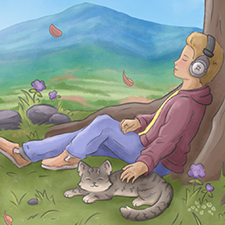Leaderboard
Popular Content
Showing content with the highest reputation on 04/24/2024 in all areas
-
Additional ears? You got it. I'm coming in cold on this one so you're going to get all of my impressions - not saying that all of this needs to be addressed to pass a resubmission, but hopefully you can make use of the brain dump. The intro brings some really cool flavor - the noisy distorted elements remind me of Porter Robinson's Fellow Feeling (see the 3:00 mark if you're short on time.) If you're going for random blasts of noise, I think this works - if you're trying to make it sound like footsteps stomping through, it's not giving that impression at all because every stomp is exactly the same. There's no variation in the sample and it reaches uncanny valley territory fast when you play the sample multiple times in a row. This all boils down to what you are going for here, but either way, I think some subtle variation with each repetition of the sample/layer of samples (without knowing how you actually did this) would build immersion. Some of your orchestral elements (flute, glock) are very resonant, oftentimes peaking at their fundamental frequency between 3-6db above everything else. The bells in the intro also feel comparably dry. This will probably get ironed out in your next pass, but I'm going to point it out anyway. The orchestral sequencing sounds workable for the most part, you're getting good mileage out of your samples. It's not the best but I do think you're using them effectively for the most part - the main areas that sound really noticeably fake are the half-step chromatic runs on the strings at times like 2:48. I just don't think the big ensemble patch moves fast enough to accommodate that writing, and would recommend adjusting the lead writing to fit better within the limitations of your samples. I also feel like the intro could use some deeper sub bass presence. It's not that the stomps aren't contributing any bass frequencies, but a big cinematic sub drop or sustained bass to accompany the stomps (see Fellow Feeling) would make this feel much more dynamic, or have some risers building up tension in the low end leading into :49. The decision to intersperse various melodic elements (glock, harmonic strings, cello) was a good one - otherwise, this intro would be way too long. It already feels a bit lengthy as-is, but those additions help pad it out quite a bit and justify the length. However, this gets to the problem of transitions and buildup, which I think is my biggest gripe currently. There is rarely much going on to signal that we're approaching a new musical idea, so even though you have some very dramatic changes throughout your arrangement (which are quite inspired and interesting, I must add!) they come on very suddenly. Cinematic risers, fills, sweeps, etc. are a part of this equation and could definitely be used to greater effect here to bridge your gaps, but there's another element I want to touch on: the idea of movement in your part writing. You do a great job building atmosphere and have all the makings of a very dramatic song, but there's a lack of movement on a compositional level. When cinematic music is clicking well, composition and sound design have a lot of synergy. Right now, you are doing a good job building an interesting sound palette for each individual section, but the underlying chord progression feels weak. It hovers around the tonic chord for most of the time, and even when you do have chord changes, they don't feel properly supported with anything strong in the lower frequencies. This is where a bit of music theory troubleshooting could go a long way - your melody has many opportunities for powerful chord movements that build drama and tension, especially as you lead into new sections, but you're not fully capitalizing on that potential. I don't think it would even require changing up much fundamental about the rest of the parts; just identify the chord progression you're playing and make sure that there's strong support in the bass for whatever chord/root note you're trying to play. I don't know how else to suggest addressing this without studying up on some fundamentals of music theory, but certain chords just move naturally into others and can help you allude to future changes and help transition between vastly different musical ideas in a way that feels rewarding. I think you're running up against some of the same problems I faced before I made the decision to finally start researching music theory. I had a conceptual idea in my brain for what each section of my song was supposed to do, and could support it in terms of selecting sounds and picking grooves/effects/etc., but it boiled down to luck whether or not it worked on a fundamental composition level, and I spun my wheels trying to fix that issue with every other production tool known to man. I think if you were to pick an area to focus on, the big orchestral section starting at 2:36 would be where I'd focus my energy most. Everything else before and after that can skate by a little easier, but when you're trying to make a big melodic orchestral statement, the fundamentals need to be strong first. Figure out what chord you're playing on each measure and map them out in sequence using just a basic patch. I find that it helps to actually just plot my chord progressions out on piano so there's no temptation to get distracted by sound design. See if the song sounds strong and compelling when it's just played on a single instrument, and go from there.1 point
-

OCR04687 - *YES* Super Metroid "BLOOD CONSTRICTION" *RESUB*
prophetik music reacted to Chimpazilla for a topic
*Checks submission thread* Ok so this track has been updated NINE times??? First, that's too many updates. Second, we need a better way to have more visibility when submissions have been updated. I'm still cool with my YES on the track as of the 4/13 version.1 point

